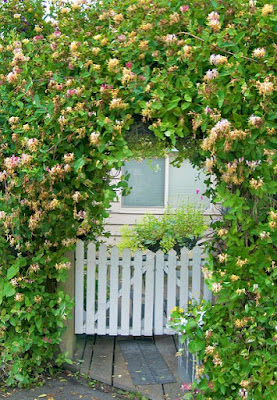 |
| Honeysuckle by Trish Steel, CC BY-SA 2.0, via Wikimedia Commons |
"And bid her steal into the pleached bower,
Where honeysuckles, ripen'd by the sun
Forbid the sun to enter."
Forbid the sun to enter."
- Much Ado About Nothing, Act III, Scene 1
Where oxlips and the nodding violet grows,
Quite over-canopied with luscious woodbine."
- A Midsummer Night's Dream, Act II, Scene 1
“Sleep thou, and I will wind thee in my arms ...
So doth the woodbine the sweet honeysuckle
Gently entwist; the female ivy so
Enrings the barky fingers of the elm.
O, how I love thee! how I dote on thee!"
- A Midsummer Night's Dream, Act IV, Scene 1
The English Honeysuckle or Common Honeysuckle (Lonicera periclymenum) is a fast growing, climbing shrub native to the British Isles, it can be found growing wild in woodlands and in hedgerows. From midsummer to early autumn it produces fragrant pink and yellow flowers. It is also known as Woodbine, often Woodbine refers to the vine and the name Honeysuckle refers to its sweet smelling flowers. However in some early writings the name Woodbine was applied to any creeping or climbing plant, likewise Honeysuckle was a name used for a variety of fragrant plants.
The English Honeysuckle was an emblem of love, devotion and affection, as it quickly grows and entwines itself around any tree or plant it is near. Shakespeare also uses it as a metaphor for embracing arms.
The English Honeysuckle was an emblem of love, devotion and affection, as it quickly grows and entwines itself around any tree or plant it is near. Shakespeare also uses it as a metaphor for embracing arms.
 |
| https://www.flickr.com/photos/adavey/3753822096 |
In Elizabethan gardens Honeysuckle was a popular climbing plant used in arbours, decorative archways and bowers. It was especially valued for its sweet fragrance. The physician and herbalist John Bullein wrote in his Book of Simples (1562) "Oh, how swete and pleasant is Woodbine, in woodes or arbours, after a tender, soft rain." The fragrance on Honeysuckle is most noticeable late in the evenings and at night. Honeysuckle will also attract birds and bees to your garden.
Type: Deciduous in winter; evergreens in spring or autumn
Height: Up to 20 feet if supported
When to Plant: Spring, avoid cold climates
Flowers: June to September
